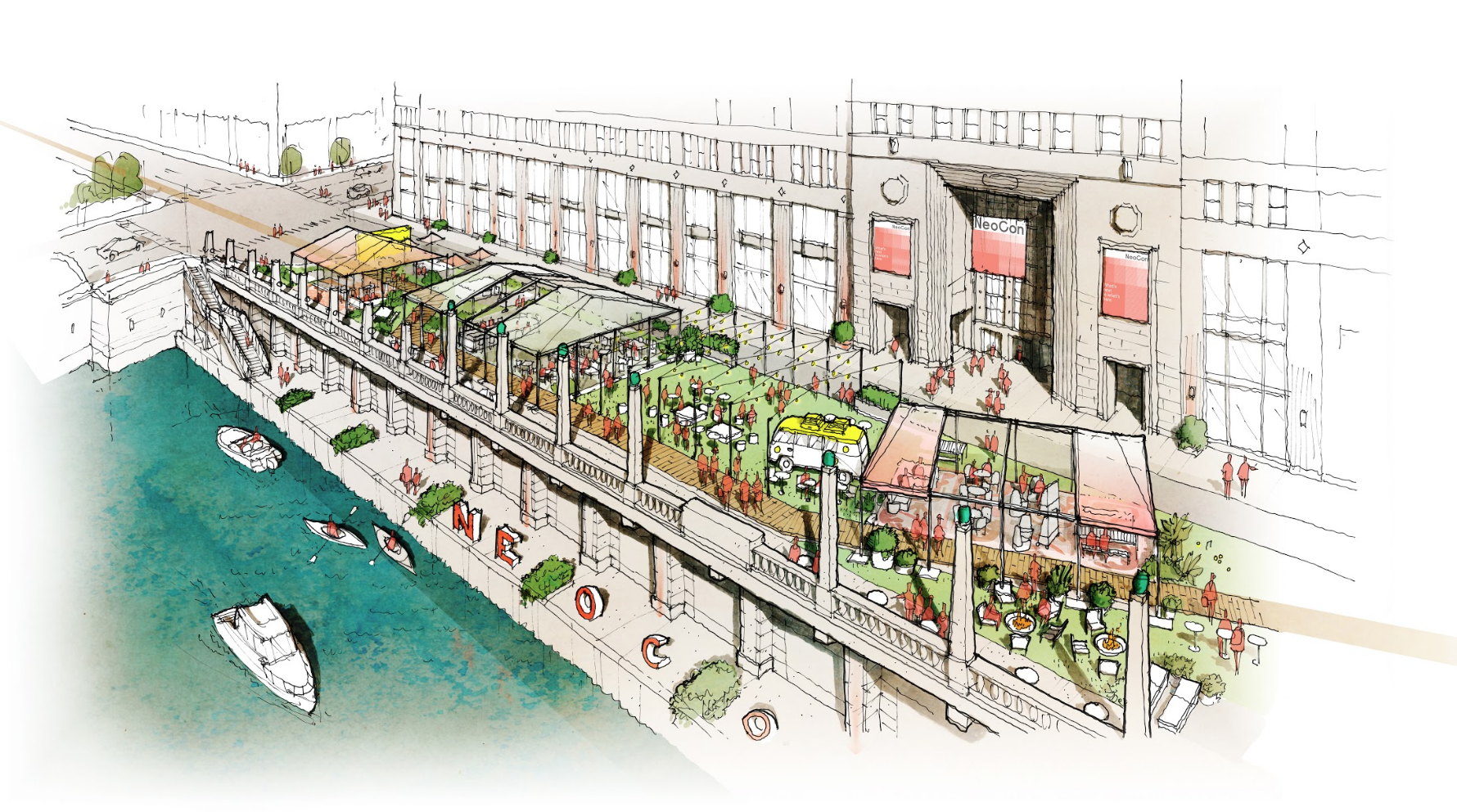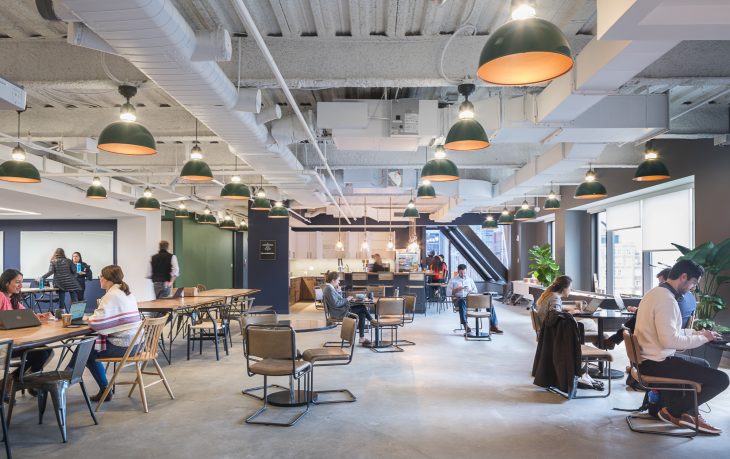The NeoCon 2019 proposals offered an incredible array of topics from all sectors of the industry. Here are a few of the seminars that caught our eye. Check out part one here and part two here.
WDM continues our preview of selected NeoCon 2019 seminars with a focus on workplace issues with additional insight on the issues that our readers are interested in. A discussion with Ashley Dunn, Director of Workplace at Dyer Brown Architects was most informative.
Conflicting Workplace Trends – A Framework for Solutions
Wednesday June 12 8:00 AM – 9:00 AM
WDM: Clients now bring a bit more into the conversation when initiating workplace projects (my observation). What do you think is driving this? Is it the HGTV effect? Does everyone want to be a designer? Is it all of the “open plan is dead” articles? Is it the expanded group of participants in planning workplace projects?
AD: There is a ton of information available to our clients on the web and in print, including some authoritative, useful studies and some wild opinion. Some of our clients come to us asking for help sorting through it all — there’s a lot of contradictory and conflicting ideas out there, creating confusion. Others enter the conversation thinking they know exactly what the best approach is. Overall, this is a good thing: Clients are coming to us informed, somewhat at least, even if they may lack the expertise to interpret the information in a way that will be beneficial. Clients who have done their research are clients who are interested in engaging in a process that will ultimately deliver an effective workplace tailored to their culture and goals.

WDM: In setting up project teams, with multiple stakeholders, what are the three most challenging aspects of figuring out who gets to drive the bus (so to speak)?
AD: One of the most challenging aspects of project leadership is separating the desires of leadership from the needs of the day to day staff and facilities managers. The latter two ted to know how workspaces are used and what workplace patterns need new solutions, but leadership is responsible for the overall company vision. Both viewpoints are important, and balance is key. Another major challenge is having a cohesive project committee, if there is one. Often, we encounter turf battles, or worries about overpromising among those groups. Or, there is a blue-sky faction and a grumpy realist faction, and we need to mediate their disconnects. A last challenge is encouraging workplace users to voice their opinions, even if those opinions are not shared by management. Conversely, leaders and managers should take staff feedback into account, not just to pay lip service to employee engagement, but to truly get at what people want and need from their space.

WDM: How do you negotiate the discussions around which trends are valid in each situation? Sometimes end users plunge into a project with the expectation of providing some trendy feature but, it might not be the right solution for that organization, how do you set them straight?
AD: In visioning sessions and engagement workshops with clients, there are no ‘wrong’ answers, each participant is encouraged to weigh in, and some of the most valuable discussion happens not between the design team and the client, but between two end users with differing opinions. Our goal in leading the sessions is to identify the specific corporate culture, understand the kinds of work being performed and facilitate discussions that draw out issues and desires from a wide range of staff. This is critical for delivering a high-performing workplace that supports the company’s goals. By the time we have entered the design phase, our clients feel more informed on the latest trends and how they, as a group of colleagues, feel about those trends, so that they can make better decisions about what works for their space. During that process, their opinion on a trend may have completely changed, or anyway, they can see why trends are less important than a solution tailored for them.
We also caught up with Gensler’s Todd Heiser, Managing Director, Chicago, and Contract Magazine Editor in Chief, Paul Makovsky, to find out more about their presentation topic:
The Outdoor Office – The Next Big Thing
Monday, June 10 – 4:00 PM – 5:00 PM
WDM: Over the past year, there have been several stories about working outside – (i.e. LL Bean’s outside office). With the current trend to wellness in the workplace, what do you think are the three main things that will generate new places where the ability to work outside will occur?
TH: Through the most recent Gensler’s US Workplace Survey, we know an effective workplace is critical, but it’s no longer enough: employees want, and expect, a “great” experience at work – spaces with mostly open environments combined with high levels of choice, variety and balance. Adding an outdoor element is another step in the evolution of choice.
We also know great workplaces have direct benefits: more engaged employees are key to business productivity and profit and mostly open environments – both indoors and outdoors – deliver the highest effectiveness and experience scores. Again, this is driven by high levels of choice, variety and balance.

High performers work everywhere – experience matters both inside and outside the workplace. Our research shows that employees with a great workplace experience are 4x more likely to be in balanced environments. The data and research by Gensler say the top five work-focused amenities are innovation hubs, maker spaces, quiet/tech-free zones, focus rooms, and outdoor workspaces. These deliver the greatest impact on experience and effectiveness.
WDM: How hard is it to convince clients to include outdoor space as part of an overall design program?
TH: Our clients are at the center of everything we do, they often drive these kinds of innovative solutions from their culture into the final design. As strategic partners, the design and the strategy behind it usually starts and ends with data and research. The Gensler Experience Index cites that while 80 percent of executives rate employee experience as very important. To engage talent, the workplace must prioritize experience – it’s no longer just an option.
The benefit of outdoor workspaces is no exception. As companies compete to attract top talent, workplace design is the go-to recruiting tool. Current and future talent will weight their job options more critically, so leadership teams need to appeal to their people with creative workspace, in-house amenities and communal spaces and offices that bring their people together.
WDM: How is the market gearing up to design and provide more options for outdoor workspace furnishings for this burgeoning trend? What are you seeing?
PM: When it comes to product offerings for outdoor workspaces, manufacturers can’t just translate the hospitality cabana look to an outdoor workplace. New propositions are finally addressing this new trend. Landscape Forms has collaborated with Struxure Outdoor to create a new flexible outdoor structural system to create outdoor environments; and Kettal, the Spanish manufacture is creating pavilions that can be used indoors or outdoors as enclosed workspaces or meeting rooms. We’re also seeing smaller products that will enrich any outdoor workplace—from contemporary bird feeders and planters for workplace gardens to outdoor fireplaces and kitchens that go way beyond the backyard barbecue.
What are the challenges of providing viable outdoor workspaces?
PM: The first thing that comes to mind is weather, of course. The second is technology. There are some real innovative solutions starting to come out at the commercial level that allow for outside technology meant for a myriad of weather situations and setups.



[…] The NeoCon 2019 proposals offered an incredible array of topics from all sectors of the industry. Here are a few of the seminars that caught our eye. Check out part one here; part two here; and part three here. […]